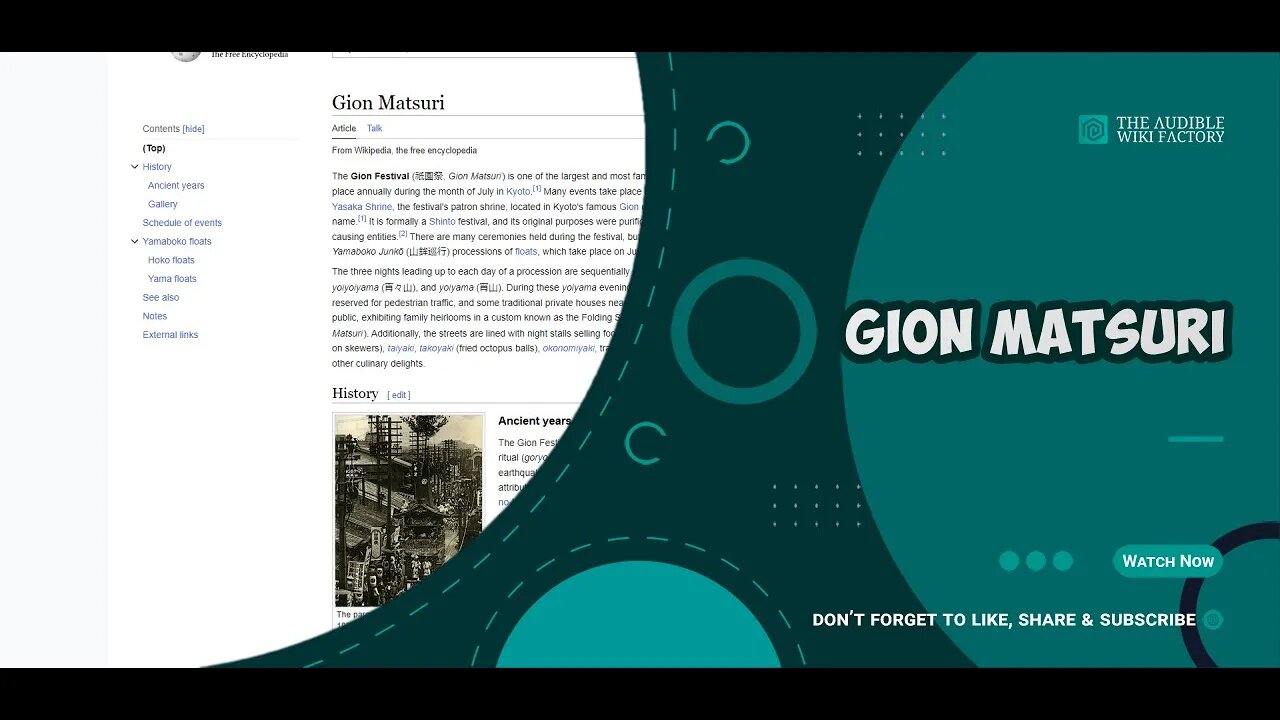Premium Only Content

The Gion Festival is one of the largest and most famous festivals in Japan, taking place
The Gion Festival is one of the largest and most famous festivals in Japan, taking place annually during the month of July in Kyoto. Many events take place in central Kyoto and at the Yasaka Shrine, the festival's patron shrine, located in Kyoto's famous Gion district, which gives the festival its name. It is formally a Shinto festival, and its original purposes were purification and pacification of disease-causing entities. There are many ceremonies held during the festival, but it is best known for its two Yamaboko Junkō processions of floats, which take place on July 17 and 24.
The three nights leading up to each day of a procession are sequentially called yoiyoiyoiyama, yoiyoiyama, and yoiyama. During these yoiyama evenings, Kyoto's downtown area is reserved for pedestrian traffic, and some traditional private houses near the floats open their entryways to the public, exhibiting family heirlooms in a custom known as the Folding Screen Festival, Byōbu Matsuri). Additionally, the streets are lined with night stalls selling food such as yakitori (barbecued chicken on skewers), taiyaki, takoyaki (fried octopus balls), okonomiyaki, traditional Japanese sweets, and many other culinary delights.
HISTORY
ANCIENT YEARS
The Gion Festival originated during an epidemic as part of a purification ritual (goryo-e) to appease the gods thought to cause fire, floods, and earthquakes. In 869, when people were suffering from a plague attributed to vengeful spirits, Emperor Seiwa ordered prayers to Susanoo-no-Mikoto, the god of the Yasaka Shrine. Sixty-six stylized and decorated halberds, one for each of the traditional provinces of Japan, were prepared and erected at Shinsen-en, a garden in the south of the imperial palace, along with mikoshi ( 'portable shrines') from Yasaka Shrine. This practice was repeated wherever an outbreak of plague occurred. By the year 1000, the festival became an annual event and it has since seldom failed to take place. During the civil Onin War (under the Ashikaga shogunate), central Kyoto was devastated, and the festival was halted for three decades in the late 15th and early 16th centuries. Later in the 16th century, it was revived by the shogun Oda Nobunaga.
Over the centuries, some floats have been destroyed or otherwise lost, and in recent years several have been restored. Float neighborhood associations sometimes purchase antique tapestries to replace worn or destroyed ones, or commission replicas from industrial weavers in Kyoto, or design and commission new ones from the weavers of Kyoto's famous traditional Nishijin weaving district. When they are not in use, the floats and regalia are kept in special storehouses throughout the central district of Kyoto, or at Yasaka Shrine.
The festival serves as an important setting in Yasunari Kawabata's novel, The Old Capital, in which he describes the Gion Festival as one of "the 'three great festivals' of the old capital", along with the Festival of Ages and the Aoi Festival.
LINK TO ARTICLE: http://en.wikipedia.org/wiki/Gion_Matsuri
TAGS: Gion Matsuri, Gion faith, 9th-century establishments in Japan, Summer events in Japan, 1530s in Japan, 970 establishments, 869 establishments, Cultural festivals in Japan, Tourist attractions in Kyoto, Shinto in Kyoto, Shinto festivals, Festivals in Kyoto, Religious festivals in Japan
#GeneralKnowledge #AudibleWikiFactory #Audible #Wikipedia #GionMatsuri
-
 41:13
41:13
The Audible Wiki Factory
2 years agoThe Oktoberfest is the world's largest Volksfest, featuring a beer festival and a travelling
443 -
 LIVE
LIVE
Badlands Media
7 hours agoBadlands Daily: August 26, 2025
3,849 watching -
 LIVE
LIVE
GritsGG
2 hours agoWin Streaking! Coloring Hair at End of Stream! Most Wins 3435+ 🧠
233 watching -

Dear America
2 hours agoNO MORE BURNING FLAGS!! 🇺🇸 Trump Signs Order Making It ILLEGAL!! + Trump Is SUING NEWSOM!
73.8K53 -
 LIVE
LIVE
JuicyJohns
2 hours ago $0.64 earned🟢#1 REBIRTH PLAYER 10.2+ KD🟢
147 watching -

Law&Crime
1 hour ago $0.63 earnedLIVE: Adelson Matriarch Murder Trial — FL v. Donna Adelson — Day 3
10.7K -
 LIVE
LIVE
Major League Fishing
4 days agoLIVE! - Fishing Clash Team Series: Challenge Cup - Day 3
222 watching -
 LIVE
LIVE
Surviving The Survivor: #BestGuests in True Crime
1 hour agoCourt Stream: Donna Adelson Trial DAY 3 of Testimony
99 watching -
 LIVE
LIVE
Wendy Bell Radio
6 hours agoWhat Hill Will Democrats Choose To Die On?
8,316 watching -
 1:15:15
1:15:15
JULIE GREEN MINISTRIES
4 hours agoTHE CIA HAS BEEN A GIANT IN THIS LAND THAT WILL BE TAKEN OUT
91.4K146